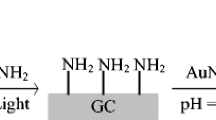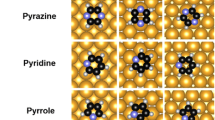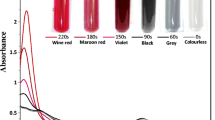Abstract
Gold nanoparticles (AuNPs) have been widely used in many areas, and the nanoparticles usually have to be functionalized with some molecules before use. However, the information about the characterization of the functionalization of the nanoparticles is still limited or unclear, which has greatly restricted the better functionalization and application of AuNPs. Here, we propose a chemical way to accurately characterize the functionalization of AuNPs. Unlike the traditional physical methods, this method, which is based on the catalytic property of AuNPs, may give accurate coverage rate and some derivative information about the functionalization of the nanoparticles with different kinds of molecules. The performance of the characterization has been approved by adopting three independent molecules to functionalize AuNPs, including both covalent and non-covalent functionalization. Some interesting results are thereby obtained, and some are the first time to be revealed. The method may also be further developed as a useful tool for the characterization of a solid surface.





Similar content being viewed by others
References
Biella S, Prati L, Rossi M (2002) Selective oxidation of d-glucose on gold catalyst. J Catal 206(2):242–247
Boisselier E, Astruc D (2009) Gold nanoparticles in nanomedicine: preparations, imaging, diagnostics, therapies and toxicity. Chem Soc Rev 38(6):1759–1782
Carrettin S, Blanco MC, Corma A, Hashmi ASK (2006) Heterogeneous gold-catalysed synthesis of phenols. Adv Synth Catal 348(10–11):1283–1288
Comotti M, Della Pina C, Matarrese R, Rossi M (2004) The catalytic activity of “naked” gold particles. Angew Chem Int Ed 43(43):5812–5815
Comotti M, Della Pina C, Falletta E, Rossi M (2006a) Aerobic oxidation of glucose with gold catalyst: hydrogen peroxide as intermediate and reagent. Adv Synth Catal 348(3):313–316
Comotti M, Pina CD, Rossi M (2006b) Mono- and bimetallic catalysts for glucose oxidation. J Mol Catal A Chem 251(1–2):89–92
Demers LM, Mirkin CA, Mucic RC, Reynolds RA, Letsinger RL, Elghanian R, Viswanadham G (2000) A fluorescence-based method for determining the surface coverage and hybridization efficiency of thiol-capped oligonucleotides bound to gold thin films and nanoparticles. Anal Chem 72(22):5535–5541
Dreaden EC, Alkilany AM, Huang X, Murphy CJ, El-Sayed MA (2012) The golden age: gold nanoparticles for biomedicine. Chem Soc Rev 41(7):2740–2779
Fan Q, Zhao J, Li H, Zhu L, Li G (2012) Exonuclease III-based and gold nanoparticle-assisted DNA detection with dual signal amplification. Biosens Bioelectron 33(1):211–215
Hashmi ASK (2012) Sub-nanosized gold catalysts. Science 338(6113):1434
Hashmi ASK, Hutchings GJ (2006) Gold catalysis. Angew Chem Int Ed 45(47):7896–7936
He L, Musick MD, Nicewarner SR, Salinas FG, Benkovic SJ, Natan MJ, Keating CD (2000) Colloidal Au-enhanced surface plasmon resonance for ultrasensitive detection of DNA hybridization. J Am Chem Soc 122(38):9071–9077
Hong WJ, Bai H, Xu YX, Yao ZY, Gu ZZ, Shi GQ (2010) Preparation of gold nanoparticle/graphene composites with controlled weight contents and their application in biosensors. J Phys Chem C 114(4):1822–1826
Ishida T, Kinoshita N, Okatsu H, Akita T, Takei T, Haruta M (2008) Influence of the support and the size of gold clusters on catalytic activity for glucose oxidation. Angew Chem Int Ed 47(48):9265–9268
Jia JB, Wang BQ, Wu AG, Cheng GJ, Li Z, Dong SJ (2002) A method to construct a third-generation horseradish peroxidase biosensor: self-assembling gold nanoparticles to three-dimensional sol-gel network. Anal Chem 74(9):2217–2223
Larguinho M, Baptista PV (2012) Gold and silver nanoparticles for clinical diagnostics—From genomics to proteomics. J Proteomics 75(10):2811–2823
Li H, Rothberg L (2004) Colorimetric detection of DNA sequences based on electrostatic interactions with unmodified gold nanoparticles. Proc Natl Acad Sci USA 101(39):14036–14039
Liu T, Zhao J, Zhang D, Li G (2010) Novel method to detect DNA methylation using gold nanoparticles coupled with enzyme-linkage reactions. Anal Chem 82(1):229–233
Liu J, Zhang W, Zhang HL, Yang ZY, Li TR, Wang BD, Huo X, Wang R, Chen HT (2013) A multifunctional nanoprobe based on Au-Fe3O4 nanoparticles for multimodal and ultrasensitive detection of cancer cells. Chem Commun 49(43):4938–4940
Luo WJ, Zhu CF, Su S, Li D, He Y, Huang Q, Fan CH (2010) Self-catalyzed, self-limiting growth of glucose oxidase-mimicking gold nanoparticles. ACS Nano 4(12):7451–7458
Oliver-Meseguer J, Cabrero-Antonino JR, Domínguez I, Leyva-Pérez A, Corma A (2012) Small gold clusters formed in solution give reaction turnover numbers of 107 at room temperature. Science 338(6113):1452–1455
Parak WJ, Pellegrino T, Micheel CM, Gerion D, Williams SC, Alivisatos AP (2003) Conformation of oligonucleotides attached to gold nanocrystals probed by gel electrophoresis. Nano Lett 3(1):33–36
Saha K, Agasti SS, Kim C, Li XN, Rotello VM (2012) Gold nanoparticles in chemical and biological sensing. Chem Rev 112(5):2739–2779
Sperling RA, Rivera gil P, Zhang F, Zanella M, Parak WJ (2008) Biological applications of gold nanoparticles. Chem Soc Rev 37(9):1896–1908
Stratakis M, Garcia H (2012) Catalysis by supported gold nanoparticles: beyond aerobic oxidative processes. Chem Rev 112(8):4469–4506
Wang J, Meng W, Zheng X, Liu S, Li G (2009) Combination of aptamer with gold nanoparticles for electrochemical signal amplification: application to sensitive detection of platelet-derived growth factor. Biosens Bioelectron 24(6):1598–1602
Wang YL, Salehi M, Schutz M, Rudi K, Schlucker S (2013) Microspectroscopic SERS detection of interleukin-6 with rationally designed gold/silver nanoshells. ACS Nano 4(11):6725–6734
Wu Y, Liu LK, Liang ZQ, Shen ZM, Zhu XL (2011) Colorimetric and electrochemical study on the interaction between gold nanoparticles and unmodified DNA. Curr Nanosci 7(3):359–365
Xie W, Christoph H, Karsten K, Markus H, Sebastian S (2011) Synthesis of bifunctional Au/Pt/Au core/shell nanoraspberries for in situ SERS monitoring of platinum-catalyzed reactions. J Am Chem Soc 133(48):19302–19305
Xu Y, Wang J, Cao Y, Li G (2011) Gold nanoparticles based colorimetric assay of protein poly(ADP-ribosyl)ation. Analyst 136(10):2044–2046
Zanchet D, Micheel CM, Parak WJ, Gerion D, Alivisatos AP (2001) Electrophoretic isolation of discrete Au nanocrystal/DNA conjugates. Nano Lett 1(1):32–35
Zeng SW, Yong KT, Roy I, Dinh XQ, Yu X, Luan F (2011) A review on functionalized gold nanoparticles for biosensing applications. Plasmonics 6(3):491–506
Zhao J, Liu T, Fan Q, Li G (2011) A new strategy for a DNA assay based on a target-triggered isothermal exponential degradation reaction. Chem Commun 47(18):5262–5264
Zheng XX, Liu Q, Jing C, Li Y, Li D, Luo WJ, Wen YQ, He Y, Huang Q, Long YT, Fan CH (2011) Catalytic gold nanoparticles for nanoplasmonic detection of DNA hybridization. Angew Chem Int Ed 50(50):11994–11998
Zhu XL, Li YX, Yang JH, Liang ZQ, Li GX (2010) Gold nanoparticle-based colorimetric assay of single-nucleotide polymorphism of triplex DNA. Biosens Bioelectron 25(9):2135–2139
Acknowledgments
This work is supported by the National Science Fund for Distinguished Young Scholars (Grant No. 20925520), the National Natural Science Foundation of China (Grant Nos. 61001035, 21235003), the “Chen Guang” project of Shanghai Municipal Education Commission and Shanghai Education Development Foundation (No. 10CG42), the Innovation Program of Shanghai Municipal Education Commission (No. 12YZ004), and the Shanghai Science and Technology Committee (Grant No. 11DZ2272100).
Author information
Authors and Affiliations
Corresponding author
Electronic supplementary material
Below is the link to the electronic supplementary material.
Rights and permissions
About this article
Cite this article
Zhu, X., Liu, M., Zhang, H. et al. A chemical approach to accurately characterize the coverage rate of gold nanoparticles. J Nanopart Res 15, 1900 (2013). https://doi.org/10.1007/s11051-013-1900-2
Received:
Accepted:
Published:
DOI: https://doi.org/10.1007/s11051-013-1900-2




